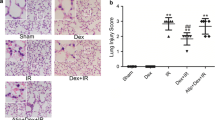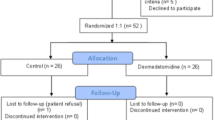Abstract
Lung N-methyl-D-aspartate receptors (NMDAR) may cause excitotoxic pulmonary edema if activated. Acute lung injury may be mediated by oxidative stress, frequently generated by local or remote ischemia and reperfusion (IR). This experimental study assessed the effects of intravenous dextromethorphan, an NMDAR antagonist, on reperfusion lung injury following superior mesenteric artery (SMA) clamping/unclamping. SMA of 48 (12 per group) anesthetized adult male Wistar rats was clamped for 90 min (IR); 48 additional rats underwent a sham laparotomy (control). The experimental timeframe was identical in all groups. Ten minutes before unclamping, three dextromethorphan doses were administered intravenously in three IR and three control groups, followed by 3 h of respiratory and hemodynamic assessment and postexperimental assessment of survival. Intravenous 10 and 20 mg/kg dextromethorphan attenuated an 85% increase in peak ventilatory pressure, a 45% reduction in PO2/FiO2, 4–12-fold increase in bronchoalveolar lavage-retrieved volume, and polymorphonuclear leukocytes/bronchoalveolar cells ratio, all associated with SMA unclamping in the IR-nontreated and the IR-40 mg/kg dextromethorphan-treated rats. Lung tissue polymorphonuclear leukocyte count, total xanthine oxidase activity, reduced glutathione, and wet-to-dry weight ratio were all within normal ranges in the two lower-dose-treated groups. These effective regimens were also associated with longer postexperimental animal survival. Dextromethorphan was not associated with changes in three control groups. Thus, Intravenous dextromethorphan mitigates lung reperfusion injury following SMA clamping/unclamping in a dose-dependent manner. This is a novel potential use of dextromethorphan in vivo.




Similar content being viewed by others
References
Barnard ML, Baker RR, Matalon S (1993) Mitigation of oxidant injury to lung microvasculature by intratracheal instillation of antioxidant enzymes. Am J Physiol 265:L340–L345
Ben-Abraham R, Matza M, Marmor S, et al. (2003) Electromechanical impairment of human auricle and rat myocardial strip subjected to exogenous oxidative stress. Eur J Cardiothorac Surg 23:66–73
Britton P, Lu XC, Laskosky MS, Tortella FC (1997) Dextromethorphan protects against cerebral injury following transient, but not permanent, focal ischemia in rats. Life Sci 60:1729–1740
Buchan AM, Silvka A, Xue D (1992) The effect of the NMDA receptor antagonist MK-801 on cerebral blood flow and infarct volume in experimental focal stroke. Brain Res 574:171–177
Church J, Shacklock JA, Baimbridge KG (1991) Dextromethorphan and phencyclidine receptor ligands: differential effects on K(+)- and NMDA-evoked increases in cytosolic free Ca2+ concentration. Neurosci Lett 124:232–234
Cotgreave IA, Grafström RC, Moldeus P (1986) Modulation of pneumotoxicity by cellular glutathione and precursors. Bull Eur Physiopathol Respir 22:263s–266
Dickman KG, Youssef JG, Mathew SM, Said SI (2004) Ionotropic glutamate receptors in lungs and airways. Molecular basis for glutamate toxicity. Am J Respir Cell Mol Biol 30:139–144
Emre S, Schwartz ME, Katz E, Miller CM (1993) Liver resection under total vascular isolation. Variations on a theme. Ann Surg 217:15–19
Friedl HP, Smith DJ, Till GO, et al. (1990) Ischemia-reperfusion in humans. Appearance of xanthine oxidase activity. Am J Pathol 136:491–495
Galili Y, Ben-Abraham R, Weinbroum A, et al. (1998) Methylene blue prevents pulmonary injury following intestinal ischemia reperfusion. J Trauma 45:222–226
Gelman S (1995) The pathophysiology of aortic cross-clamping and unclamping. Anesthesiology 82:1026–1060
Hansbrough JF, Wikstrom T, Braide M, et al. (1996) Neutrophil activation and tissue neutrophil sequestration in a rat model of thermal injury. J Surg Res 61:17–22
Hashimoto S (1974) A new spectrophotometric assay method of xanthine oxidase in crude tissue homogenate. Anal Biochem 62:426–435
Inagaki N, Kuromi H, Gonoi T, Okamoto Y, et al. (1995) Expression and role of ionotropic glutamate receptors in pancreatic islet cells. FASEB J 9:686–691
Jain A, Mårtesson J, Stole E, Auld PAM, Meister A (1991) Glutathione deficiency leads to mitochondrial damage in brain. Proc Natl Acad Sci USA 88:1913–1917
Kim JJ, Moon DG, Koh SK (1998) The role of nitric oxide in vivo feline erection under hypoxia. Int J Impot Res 10:145–151
Koike K, Moore EE, Moore FA, et al. (1995) Gut phospholipase A2 mediates neutrophil priming and lung injury after mesenteric ischemia-reperfusion. Am J Physiol 268:G397–403
Kretzschmar M, Klein U, Palutke M, Schirrmeister W (1996) Reduction of ischemia-reperfusion syndrome after abdominal aortic aneurysmectomy by N-acetylcysteine but not mannitol. Acta Anaesthesiol Scand 40: 657–664
Larsen M, Webb G, Kennington S, et al. (2002) Mannitol in cardioplegia as an oxygen free radical scavenger measured by malondialdehyde. Perfusion 17:51–55
Lee F (1991) Oxidants injury to pulmonary endothelium. In: Said SI (ed) The Pulmonary Circulation and Acute Lung Injury, 2nd ed. Futura Publishing Co., Mount Kisco NY, pp 403–432
Leung JC, Travis BR, Verlander JW, et al. (2002) Expression and developmental regulation of the NMDA receptor subunits in the kidney and cardiovascular system. Am J Physiol Regul Integr Comp Physiol 283:R964–971
Lu YT, Hellewell PG, Evans TW (1997) Ischemia-reperfusion lung injury: contribution of ischemia, neutrophils, and hydrostatic pressure. Am J Physiol 273:L46–54
Nielsen VG, Weinbroum A, Tan S, et al. (1994) Xanthine oxidoreductase release after descending thoracic aorta occlusion and reperfusion in rabbits. J Thorac Cardiovasc Surg 107:1222–1227
Polak MJ, Xiao S, Ashton CA, Baylis C (2002) NMDA alters the development of hypoxic pulmonary vasoconstriction and nitric oxide synthetase activity in the isolated perfused rat lung. Exp Lung Res 28:251–263
Price DD, Mao J, Frenk H, Mayer DJ (1994) The N-methyl-D-aspartate receptor antagonist dextromethorphan selectively reduces temporal summation of second pain in man. Pain 59:165–174
Reynolds IJ, Hastings TG (1995) Glutamate induces the production of reactive oxygen species in cultured forebrain neurons following NMDA receptor activation. J Neurosci 15:3318–3327
Said SI (1991) Glutamate receptors and asthmatic airway disease. Trends Pharmacol Sci 20:132–135
Said SI, Berisha HI, Pakbaz H (1996) Excitoxicity in the lung: N-methyl-D-aspartate-induced, nitric oxide-dependent, pulmonary edema is attenuated by vasoactive intestinal peptide and by inhibitors of poly (ADP-ribose) polymerase. Proc Natl Acad Sci USA 93:4688–4692
Said SI, Pakbaz H, Berisha HI, Raza S, Foda HD (2000) NMDA receptor activation: critical role in oxidant tissue injury. Free Radic Biol Med 28:1300–1302
Schmid-Elsaesser R, Zausinger S, Hungerhuber E, Baethmann A, Reulen HJ (1998) Monotherapy with dextromethorphan or tirilazad—but not a combination of both—improves outcome after transient focal cerebral ischemia in rats. Exp Brain Res 122:121–127
Shen W, Zhang C, Zhang G (2002) Nuclear factor kappaB activation is mediated by NMDA and non-NMDA receptor and L-type voltage-gated Ca(2+) channel following severe global ischemia in rat hippocampus. Brain Res 933:23–30
Steinberg GK, Kunis D, DeLaPaz R, Poljak A (1993) Neuroprotection following focal cerebral ischaemia with the NMDA antagonist dextromethorphan, has a favourable dose response profile. Neurol Res 15:174–180
Terada LS, Dormish JJ, Shanley PF, et al. (1992) Circulating xanthine oxidase mediates lung neutrophil sequestration after intestinal ischemia-reperfusion. Am J Physiol 263:L394–401
Tortella FC, Britton P, Williams A, Lu XC, Newman AH (1999) Neuroprotection (focal ischemia) and neurotoxicity (electroencephalographic) studies in rats with AHN649, a 3-amino analog of dextromethorphan and low-affinity N-methyl-D-aspartate antagonist. J Pharmacol Exp Ther 291:399–408
Weinbroum AA (2004) Methylene blue attenuates lung injury after mesenteric artery clamping/unclamping. Eur J Clin Invest 34:436–442
Weinbroum A, Nielsen VG, Tan S, et al. (1995) Liver ischemia-reperfusion increases pulmonary permeability in rat: role of circulating xanthine oxidase. Am J Physiol 268:G988–996
Weinbroum AA, Goldman G, Kluger Y, et al. (1997) Bowel ischemia/reperfusion-induced liver and lung injury: elemental role of eicosanoids and oxygen free radicals. Med Sci Monit 3:624–630
Weinbroum AA, Hochhauser E, Rudick V, et al. (1999) Mediation of multiple organ dysfunction by radical oxygen species following remote circulatory arrest. Common mechanism of action? J Trauma 47:691–698
Weinbroum AA, Kluger Y, Shapira I, Rudick V (2001) Methylene blue abolishes aortal tone impairment induced by liver ischemia-reperfusion in a dose response manner: an isolated-perfused double-organ rat model study. Shock 15:226–230
Weinbroum AA, Goldin I, Kluger Y, Szold A (2002) Methylene blue in preventing hemodynamic and metabolic derangement following superior mesenteric artery clamping/unclamping: an intratracheal vs. intraperitoneal dose-response study. Shock 17:372–376
Woolf CJ (1996) Windup and central sensitization are not equivalent. Pain 66:105–108
Author information
Authors and Affiliations
Corresponding author
Additional information
This study was supported in part by the Italian Anonymous Family Fund, Milan, Italy.
Rights and permissions
About this article
Cite this article
Ben-Abraham, R., Guttman, M., Flaishon, R. et al. Mesenteric Artery Clamping/Unclamping-Induced Acute Lung Injury Is Attenuated by N-Methyl-D-Aspartate Antagonist Dextromethorphan. Lung 184, 309–317 (2006). https://doi.org/10.1007/s00408-006-0029-9
Accepted:
Published:
Issue Date:
DOI: https://doi.org/10.1007/s00408-006-0029-9




